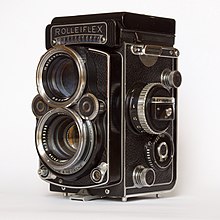Two-lens reflex camera

A two-lens reflex camera (English: Twin Lens Reflex , abbreviated TLR ) has two lenses arranged one above the other . The upper one, deflected by a mirror, creates the viewfinder image on the focusing screen, which is displayed upright but reversed. The lower one is equipped with a shutter and a diaphragm and is responsible for the exposure on the film.
properties
Both lenses are mounted on a common standard and are adjusted together for focusing. As with single-lens reflex cameras, the viewfinder allows precise setting of the focal plane. In order to ensure the brightest possible viewfinder image, the viewfinder lens is often more luminous , but has a simpler design than the recording lens for reasons of cost. The viewfinder is usually designed as a folding light shaft viewfinder, the ground glass can have a Fresnel lens for better brightness distribution, but usually has no further adjustment aids. Often there is a retractable viewfinder magnifier that allows more precise focusing, but through which it is often not possible to see the entire viewfinder image. Some of these shaft finders can also be used as simple frame finders, euphemistically sometimes called sports seekers.
Two-lens reflex cameras mostly use roll film of the type 120 or 220 and expose negatives in the format 6 × 6 . The so-called “Baby-Rollei” for roll film of the type 127 and with an image format of 4 cm × 4 cm is an exception.
Two-lens reflex cameras have both advantages and disadvantages over competing designs. The fixed mirror is simpler and cheaper than complex oscillating mirror constructions of single-lens reflex cameras and, in contrast to viewfinder cameras, allows the level of focus to be assessed. Due to the lack of mirror mechanics, these cameras are very quiet in operation and work largely vibration-free. In addition, the viewfinder image remains visible when the picture is taken, so the photographer has full control over what is happening at all times (e.g. if the person being recorded blinks when taking the picture). With the frequent light shaft viewfinder, the complete viewfinder image can be viewed with both eyes. This simplifies the composition of the picture and also enables unnoticed photography. Since the viewfinder lens works independently of the aperture setting of the taking lens or the use of a lens filter, the viewfinder image usually always has full brightness. Before the invention of the spring diaphragm , the viewfinder of single-lens reflex cameras was darkened accordingly when setting the desired aperture value for the recording. The design enables a compact and lightweight construction and makes it ideal for travel photography .
The viewfinder parallax is disadvantageous , but is usually not relevant in practice and is automatically compensated for in higher-quality models. The reversed viewfinder image takes getting used to, cameras with see-through or prism viewfinder show a reversed image.
The cost advantage of the mechanically comparatively simple construction is put into perspective in models with interchangeable lenses, since two lenses are always required. Since the two lenses are mounted relatively close to one another, there are also further restrictions with regard to the possible focal lengths and light intensities of the interchangeable lenses.
history
This type of camera was developed by the Braunschweig company Franke & Heidecke, which was later named Rollei . The Rolleiflex, introduced in 1929, and its simpler sister model , the Rolleicord, were popular cameras for photojournalists for decades. Over the years there have been other models from Mamiya (with interchangeable lenses), Zeiss, Yashica and numerous other manufacturers.
While most of the TLR cameras had already disappeared from the market, Rollei offered current models with different focal lengths until bankruptcy: the Rolleiflex 2.8FX with a lens with 80 mm, a 4.0FT with a telephoto lens with 135 mm focal length and a 4 , 0FW with a wide-angle lens with 50 mm focal length. DHW Photo Technology, the successor company to Franke & Heidecke, presented a new edition of the legendary two-lens 6 × 6 medium format camera as the Rolleiflex FX-N at photokina 2012 . In addition, there are technically much simpler and inexpensive models such as those from the Chinese manufacturer Seagull or the Russian Lubitel range .
Trivia
Looking into the viewfinder from above, which is common with two-lens reflex cameras , often leads, if not balanced, to a camera position that gives the photos taken with them a typical perspective , mockingly also called a belly perspective. With system cameras such as the Rolleiflex and Mamiya C220 / C330, this can be exchanged for a prism viewfinder, with which a laterally correct and upright image is obtained.
See also
Web links
- Official website of DHW Photo Technology - manufacturer of the two-lens Rolleiflex
- TLR camera website by Peter Wolff (English)
- Rolleiflex repair workshops worldwide from Ferdi Stutterheim (English)
- List of repair shops for mechanical cameras worldwide by Markus Keinath

